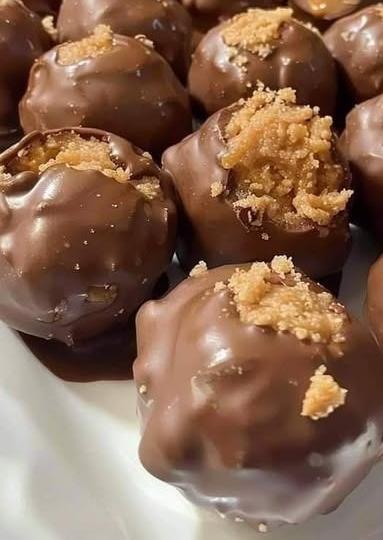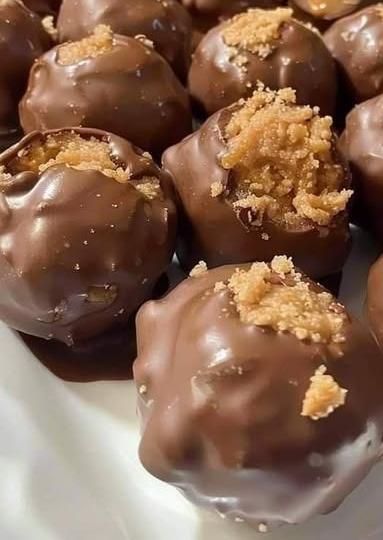
Ingredients:
- 1 cup crushed Butterfinger candy bars
- 1 cup creamy peanut butter
- 1 cup powdered sugar
- 1 cup chocolate chips (for coating)
- 1 tablespoon coconut oil (optional, for melting chocolate)
Instructions:
- Mix Ingredients:
- In a mixing bowl, combine the crushed Butterfinger bars, peanut butter, and powdered sugar. Mix until well combined.
- Form Balls:
- Roll the mixture into small balls (about 1 inch in diameter) and place them on a parchment-lined baking sheet.
- Chill:
- Refrigerate the balls for about 30 minutes to firm them up.
- Melt Chocolate:
- In a microwave-safe bowl, melt the chocolate chips and coconut oil together in 30-second intervals, stirring in between until smooth.
- Coat the Balls:
- Dip each chilled ball into the melted chocolate, ensuring they are fully coated. Use a fork to lift them out, letting the excess chocolate drip off.
- Set:
- Place the coated balls back on the parchment paper and allow the chocolate to set. You can refrigerate them again to speed up the process.
- Serve:
- Enjoy your Butterfinger Balls as a delicious treat!
Tips:
- You can add a pinch of salt to the peanut butter mixture for added flavor.
- For a fun twist, sprinkle crushed Butterfinger on top of the chocolate before it sets.
Enjoy your sweet treat!
What is Butterfinger filling made of? The filling inside a Butterfinger candy bar is made primarily of a crunchy, flaky combination of sugar, corn syrup, and peanut butter. The texture comes from the use of a process known as “candying,” where the ingredients are cooked to a specific temperature to create a brittle, crispy consistency. Here’s a general breakdown of the ingredients in the filling:
- Sugar – Sweetens and helps form the crispy texture.
- Corn Syrup – Acts as a binding agent and contributes to the smoothness of the filling.
- Peanut Butter – Provides the distinct peanut flavor.
- Hydrogenated Palm Kernel Oil – Used to stabilize the texture and keep the filling from becoming too hard.
- Other ingredients – Depending on the specific formulation, other ingredients like salt, artificial flavors, and coloring may also be used.
The result is a filling that is crunchy and flaky, almost like a peanut-butter-flavored toffee or brittle. This is coated in milk chocolate to form the signature Butterfinger bar.
What is the crispy part of a Butterfinger? The crispy part of a Butterfinger candy bar is made of a combination of sugar, corn syrup, and peanut butter, which are cooked together to form a brittle, crunchy texture. This filling is created through a candy-making process where the ingredients are heated to a high temperature, then cooled to harden and form a brittle structure. During this process, the sugar crystallizes and creates a flaky, airy texture that breaks apart easily when bitten into.
The crispy, crunchy texture is often compared to a peanut-butter-flavored toffee or brittle, and it’s this unique filling that gives Butterfinger its signature crunch.
In addition to the peanut butter, there are also ingredients like hydrogenated palm oil and sometimes vanillin (an artificial flavor), which help to stabilize the filling and contribute to its texture and taste. The result is a crispy, crunchy center that contrasts with the smooth milk chocolate coating surrounding it.
Why is Butterfinger discontinued? As of my knowledge cutoff in 2023, Butterfinger has not been fully discontinued. However, there have been changes to the product over the years that may have caused confusion regarding its availability. Here’s a breakdown of some key points regarding Butterfinger’s status and any notable developments:
1. Ownership Changes:
- Nestlé owned Butterfinger for many years, but in 2018, Ferrero Group, the Italian confectionery company (which also owns brands like Ferrero Rocher, Tic Tac, and Kinder), acquired Nestlé’s U.S. candy business. This included Butterfinger.
- After the acquisition, Ferrero revamped the Butterfinger recipe in 2019, leading to some changes in taste and texture, which disappointed some long-time fans. The company said the reformulation was aimed at improving the candy’s quality, but not all consumers were happy with the results.
2. Recipe Changes:
- The biggest change that followed the Ferrero acquisition was the reformulation of the recipe. The original recipe used partially hydrogenated oils, but the new version swapped these out for palm oil, as part of an effort to make the candy “better” and to meet evolving consumer demands for healthier ingredients. This led to some complaints, with many fans feeling that the newer version tasted different and less “crispy” than the original.
- There was also a change in the size and shape of the bars for a while, which could have contributed to some confusion about the product being discontinued.
3. Discontinuation Rumors:
- Due to some of these changes, and also because of product reformulations or changes in packaging, there have been rumors or confusion over the years about Butterfinger being discontinued. However, Ferrero Group has continued to produce the candy under its brand, though certain variations or regional availability might be affected from time to time.
4. Limited Editions and Variations:
- Over the years, Ferrero has released various limited editions and product variations (like Butterfinger Crisps, Butterfinger Bites, and seasonal versions), which might have led some people to think that the original Butterfinger bar was discontinued when it was only temporarily off the shelves or replaced by a limited edition.
In conclusion, while there have been significant changes to the recipe and formulation of Butterfinger over time, as of my last update, the candy is not permanently discontinued. However, if you’re noticing it’s hard to find in certain locations, it could be due to stock issues, product variations, or regional distribution changes.
